Posts Tagged ‘Opium’ (16 found)
Statement of the 4th Myanmar Opium Farmers’ Forum
We, opium farmers and representatives of Kayah, Kayan, Shan, Pa-O, Lahu, Ta- ang (Palaung) and Kachin opium farming communities from Kayah State, Southern, Eastern and Northern Shan State, and Kachin State, came together in Loikaw, in Kayah State in Myanmar, to discuss the challenges we face in our lives, and to share experiences and find ways to solve our problems […]
• • •Southeast Asia Opium Survey 2014 – Lao PDR, Myanmar
The roots of the opium production problem in Southeast Asia go back to the 19th century. The region is home to the “Golden Triangle”, an area long associated with opium and heroin production, located where the borders of Myanmar, Lao People’s Democratic Republic (Lao PDR) and Thailand converge along the Mekong River. Twenty years ago, the Golden Triangle was the largest heroin‐producing area in the world, supplying the region’s own demand as well as exporting its surplus to North‐east Asia, Europe and the United States of America. In the 1990s and early 2000s, national and regional efforts succeeded in reducing both opium production and trade in the region, though they subsequently increased.
• • •Opium Production in the Golden Triangle Continues at High Levels, Threatening Regional Integration
Opium poppy cultivation in Myanmar and Lao PDR rose to 63,800 hectares (ha) in 2014 compared to 61,200 ha in 2013, increasing for the eighth consecutive year and nearly tripling the amount harvested in 2006, according to the Southeast Asia Opium Survey 2014 – Lao PDR, Myanmar. […]
• • •“ဘိန္းႏြံတြင္းက ငိုရႈိက္သံ” အစီရင္ခံစာ
၁၈၈၆ တြင္ အထက္ျမန္မာျပည္ကို အဂၤလိပ္တို႔ သိမ္းပိုက္ၿပီးေနာက္ တရုတ္-ျမန္မာနယ္စပ္ တေလ်ာက္တြင္ အေရွ႕ေတာင္အာရွ၌ ဘိန္းစိုက္ပ်ဳိးထုတ္လုပ္မႈ စတင္ ထြန္းကား ရာေဒသ ျဖစ္လာခဲ့ သည္။ ျမန္မာႏိုင္ငံသည္ ၁၉၄၈ ခုႏွစ္တြင္ အဂၤလိပ္တို႔ ထံမွ လြတ္လပ္ေရး ရရွိခဲ့ေသာ္လည္း ရွမ္းျပည္နယ္မွ ဘိန္းစိုက္ပ်ဳိး ထုတ္လုပ္ မႈသည္ အနာဂတ္တြင္ ျပႆနာမ်ားျဖစ္ထြန္းမႈ ပိုမိုႀကီးထြား လာေစသည့္ မ်ဳိးေစ့မ်ားကို ခ်ထားၿပီး ျဖစ္ေနသည္။ […]
• • •ဘိန္းႏံြတြင္းမွ ျပည္သူတို႔၏ ငိုရႈိက္သံမ်ားကို တာ၀န္ရွိသူတိုင္းက ၾကားသိကယ္တင္ႏိုင္ရန္
၂၀၀၅ မတိုင္ခင္တြင္ တိုင္းရင္းသား လက္နက္ကိုင္အဖဲြ႔ (၁၇)ဖဲြ႔ႏွင့္ ႏိုင္ငံေတာ္ အစိုးရအၾကား အပစ္အခတ္ရပ္စဲေရး ရယူခဲ့ ၾကေသာ္လည္း န၀တ၊ နအဖ အစိုးရ သည္ ႏိုင္ငံေရးျပႆနာကို ႏိုင္ငံေရးနည္းျဖင့္ မေျဖရွင္းသည့္အျပင္ ျမန္မာ-တရုတ္ နယ္စပ္ တစ္ေလွ်ာက္တြင္ စီးပြားျဖစ္ ဘိန္းစိုက္ပ်ဳိး ထုတ္လုပ္သည္ကို လွစ္လွ်ဴရႈထား ခဲ့ သျဖင့္ ျမန္မာႏိုင္ငံ၏ အေထြေထြ အၾကပ္အတည္း ျပႆနာမ်ားကို သက္ဆိုးရွည္ေစ ခဲ့သည္ဟု ယေန႔ ထုတ္ေ၀သည့္ အစီရင္ခံစာတြင္ ေဖာ္ျပထားပါသည္။ […]
• • •Burma Army Continues to Use the Drugs Trade as a Weapon of War
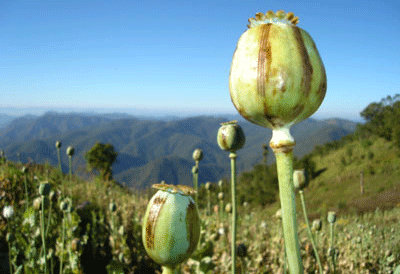 A new report by Kachin Women’s Association – Thailand (KWAT), “Silent Offensive: How Burma Army Strategies are Fuelling the Kachin Drug Crisis” outlines the severity of the drug problem in northern Burma as well as the complicity of the government in the trade. The report shows how the government is using opium-growing militia forces in its operations against the Kachin Independence Army (KIA) as part of a deal in which these militias are given free rein to produce and sell heroin and other narcotics.
A new report by Kachin Women’s Association – Thailand (KWAT), “Silent Offensive: How Burma Army Strategies are Fuelling the Kachin Drug Crisis” outlines the severity of the drug problem in northern Burma as well as the complicity of the government in the trade. The report shows how the government is using opium-growing militia forces in its operations against the Kachin Independence Army (KIA) as part of a deal in which these militias are given free rein to produce and sell heroin and other narcotics.
Thus, as the report points out, it is members of either Burma Army controlled Border Guard Forces (BGF) such as the New Democratic Army – Kachin (NDAK), a splinter group of the Kachin Independence Organization (KIO) that became a BGF in 2009, or People’s Militia Forces (PMF) that are heavily involved in offensives against the KIO. Land that is taken by the Burma Army and its proxy forces is then allocated to BGFs/PMFs to utilize however they like. This is often opium cultivation, heroin production and methamphetamine production. To make matters worse these are areas under which the KIO had previously been involved in anti-drug activities but since BGFs or PMFs have taken over, opium cultivation has increased greatly in areas such as Nampaka in northern Shan State and Chipwi in Kachin State […]
• • •Silent Offensive: How Burma Army Strategies are Fuelling the Kachin Drug Crisis
This report, based on interviews with Kachin drug users, their family members, drug sellers, and community leaders in eight townships of northern Burma, paints a disturbing picture of the drug crisis in Kachin areas. It shows how the renewed conflict against the Kachin Independence Army (KIA) since June 2011 is fuelling drug production and worsening existing drug abuse among Kachin communities. […]
• • •New report by Kachin Women’s Association Thailand: Burmese Military Strategies Fuelling Kachin Drug Crisis
A new report exposes how anti-insurgency strategies of the Burma Army are fuelling the drug crisis in Kachin areas, particularly since the renewal of conflict against the Kachin Independence Army (KIA) in 2011 […]
• • •Opium Cultivation Bounces Back: TNI Report Shows Dramatic Failure of ASEAN’s ‘Drug Free’ Strategy
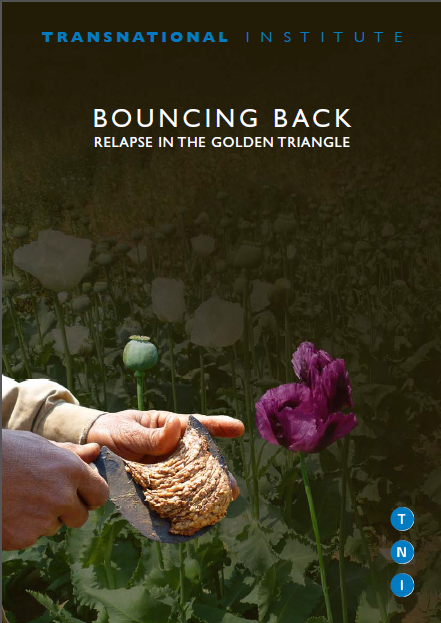 Bouncing Back – Relapse in the Golden Triangle, a new in-depth report by the Transnational Institute (TNI) launched in Yangon, Burma/Myanmar, on Monday June 2, highlights the profound changes in the illicit drugs market in the Golden Triangle – Burma, Thailand and Laos – and neighbouring India and China over the past five years. The report outlines the causes and consequences of a doubling of opium cultivation after a decade of decline. It argues that repressive drug control policies have failed to reduce consumption and production and instead led to more dangerous forms of drug use, growing human rights abuses and impoverishment. It finally highlights the workable alternatives that offer a better prospect for addressing drug-related problems in Southeast Asia. […]
Bouncing Back – Relapse in the Golden Triangle, a new in-depth report by the Transnational Institute (TNI) launched in Yangon, Burma/Myanmar, on Monday June 2, highlights the profound changes in the illicit drugs market in the Golden Triangle – Burma, Thailand and Laos – and neighbouring India and China over the past five years. The report outlines the causes and consequences of a doubling of opium cultivation after a decade of decline. It argues that repressive drug control policies have failed to reduce consumption and production and instead led to more dangerous forms of drug use, growing human rights abuses and impoverishment. It finally highlights the workable alternatives that offer a better prospect for addressing drug-related problems in Southeast Asia. […]
Latest Opium Cultivation Figures for Burma Maintain Worrying Status Quo
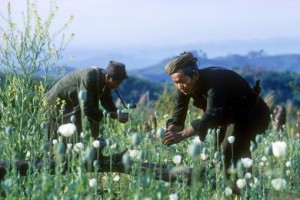 A UN Office on Drugs and Crime report released last week reveals that opium cultivation has increased in Burma for the sixth consecutive year. In 2012 there will be an estimated 690 tons of opium grown in the country, a 17% increase from last year and double that of six years ago.
A UN Office on Drugs and Crime report released last week reveals that opium cultivation has increased in Burma for the sixth consecutive year. In 2012 there will be an estimated 690 tons of opium grown in the country, a 17% increase from last year and double that of six years ago.
Poverty, caused by the inability of people to participate in sustainable livelihoods due to armed conflict and repression is a causal factor for this increase in opium cultivation. There has been much focus on Burma over recent political developments, the release of political prisoners and the easing of media restrictions. However, there has been very little focus on the lack of alternatives for people living in the conflict areas of Shan and Kachin States, where the majority of opium production occurs. There is a direct link between ongoing conflict and opium cultivation. “There is no question that there is a strong connection between the conflicts in the country and the most immediate sources of revenue to purchase weapons, and in many instances this is both opium and heroin and methamphetamine pills,” says Gary Lewis, the United Nations Office on Drugs and Crime regional representative […]


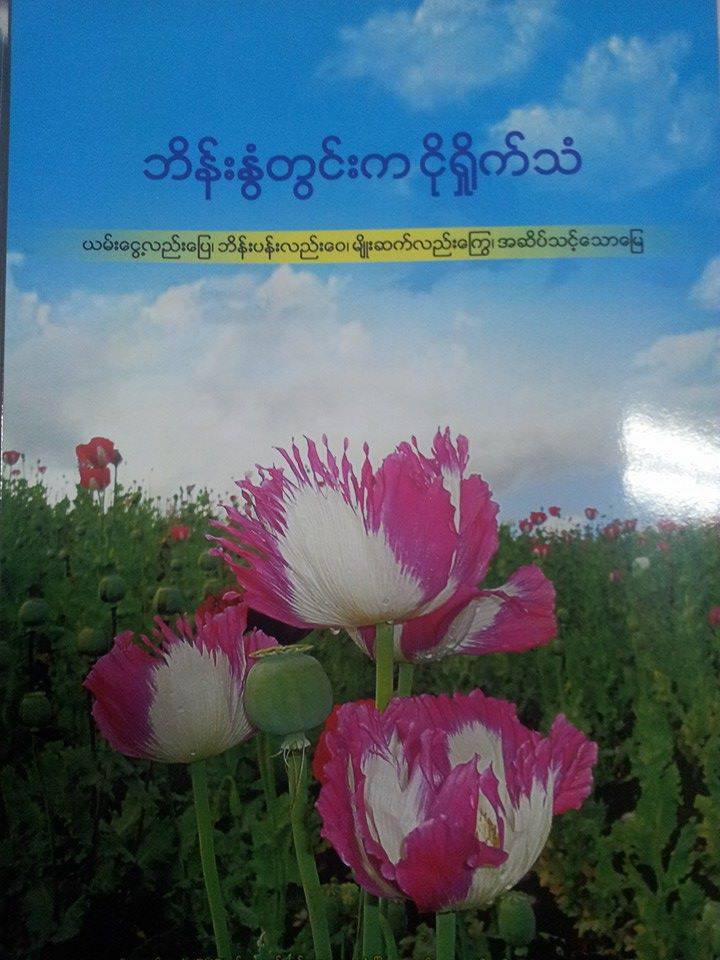
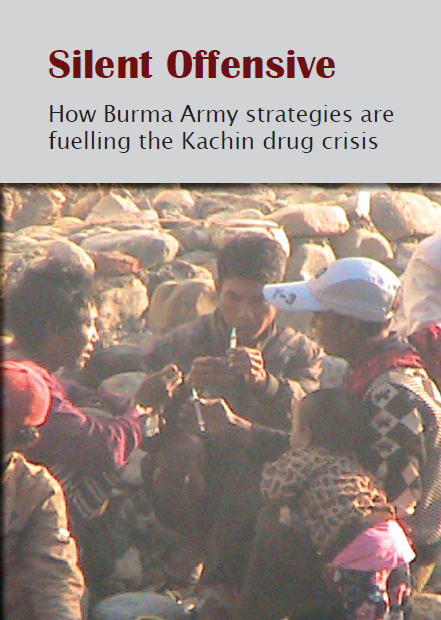








 All posts
All posts